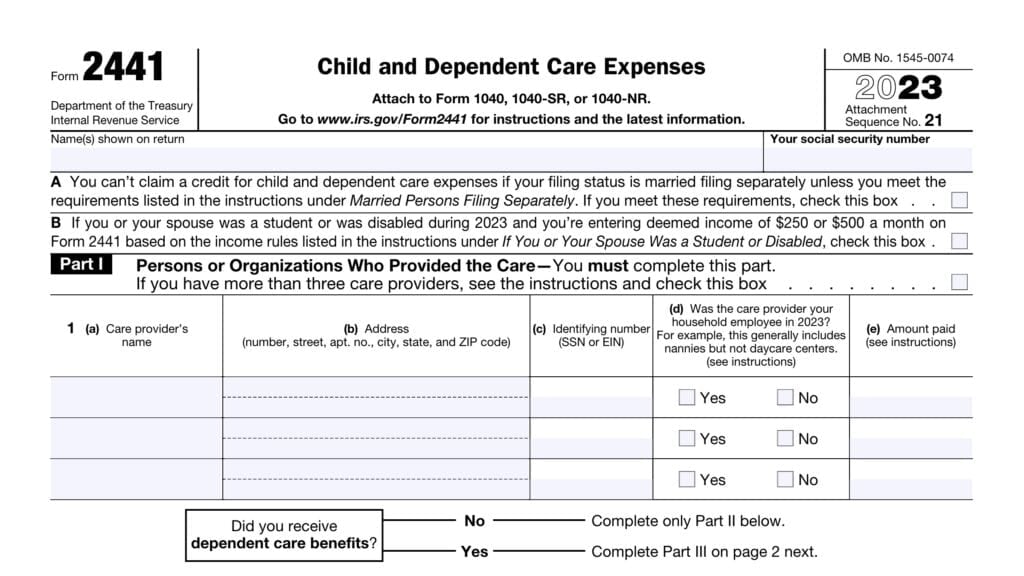IRS Form W-10 Instructions
The Internal Revenue Service provides tax benefits for people paying for child or dependent care benefits. However, due to the high frequency of tax fraud related to the child and dependent care tax credit, the IRS requires taxpayers to keep documentation of their care provider’s identity with IRS Form W-10.
In this article, we’ll walk you through this tax form, including:
- What you should expect from your care provider
- Why you should keep this form in your records
- What to do if your care provider will not give you a copy of this form
- Frequently asked questions
Let’s start with a brief look at this tax form so you know what to expect.
Table of contents
How do I complete IRS Form W-10?
If you’re the taxpayer, you’re generally not going to fill out much information on this tax form. Instead, the dependent care provider will fill in the required information in Part I.
If needed, the taxpayer may use Part II to ensure that the dependent care provider knows who requested the certification.
Let’s take a moment to review the required information fields, so that you know what to look for in your completed W-10 form.
Part I: Dependent Care Provider’s Identification
In Part I, you should expect to see the following information:
- Care provider’s name
- Provider’s address, including city, state, and ZIP code
- Taxpayer identification number
Taxpayer identification number
The tax identification number may be the care provider’s Social Security number (SSN) or individual taxpayer identification number (ITIN). If so, the box below the taxpayer identification number field will be marked. Otherwise, the tax ID number might be an employer identification number (EIN).
For providers who do not have a tax ID number: Internal Revenue Code Section 6109(a) requires all dependent care service providers to give taxpayers a valid TIN, even if the provider is not required to file an income tax return.
In other words, a care provider who does not have a TIN must obtain one. Here are the ways that a care provider may obtain a TIN.
Social Security number (SSN)
To obtain a Social Security number, you can file Form SS-5 with the Social Security Administration.
Individual taxpayer identification number (ITIN)
But if a provider is a nonresident or resident alien who doesn’t have and isn’t eligible to get an SSN, then they may complete and submit IRS Form W-7, Application for IRS Individual Taxpayer Identification Number, to the IRS.
Employer identification number (EIN)
Finally, a care provider may have an employer identification number, or EIN. If not, you may apply for one on the IRS website or by filing IRS Form SS-4, Application for Employer Identification Number.
Below Part I, you’ll need to ensure that the care provider’s signature and date are on the form.

Part II: Name and Address of Person Requesting Part I Information
In Part II, you may enter your name, street address, etc. However, if your care provider automatically gives you a completed Form W-10, you may not need to complete Part II. This form simply goes into your records for documentation purposes.
You might do this to help the care provider keep track of your information. When completing Part II, ensure to list your complete information. That way, your care provider is less likely to lose track of it.
due diligence requirements
The IRS requires taxpayers to meet certain due diligence requirements when filing IRS Form 2441 to claim a tax credit for child or dependent care expenses or to report benefits paid under an employer’s dependent care plan.
Taxpayers may meet the IRS due diligence requirements by maintaining any of the following as part of their tax records:
- Properly completed Form W-10, provided by the provider
- A copy of the provider’s Social Security card
- Recently printed letterhead or invoice showing the following information:
- Provider’s correct name
- Provider’s address
- Taxpayer identification number
- For employer-provided dependent care benefits, a copy of the statement provided by your employer under the plan
- A copy of a properly completed IRS Form W-4, if the care provider is also your household employee
If your care provider does not provide any of these documents, you may still need to retain certain information to be eligible for the child and dependent care credit. You can find additional information in the instructions for IRS Form 2441.
Video walkthrough
Watch this educational video to better understand what you should expect when your care provider gives you your Form W-10.
Frequently asked questions
IRS Form W-10 is used by taxpayers reporting child and dependent care expenses or benefits to document and verify the tax information for the dependent care provider. Taxpayers must keep a completed Form W-10, or other documentation verifying the provider’s name, address, and tax ID number in their retained records for audit purposes.
A provider who is a Section 501(c)(3) tax-exempt organization and exempt under Section 501(a) isn’t required to supply its TIN. Instead, the provider must complete the name and address lines and write “tax-exempt” in the space for the TIN.
You may still be eligible for the child care credit without a Form W-10 if you are able to report the care provider’s correct name, address, and taxpayer identification number on your completed IRS Form 2441, or if you can meet certain due diligence requirements showing your good faith efforts to obtain that information.
No. The form states, “Do NOT file Form W-10 with your tax return. Instead, keep it for your records.” Keeping your Form W-10 with your files will help you in the case of a tax audit.
How do I find IRS Form W-10?
You may find the W-10 form on the Internal Revenue Service website. For your convenience, we’ve enclosed the latest version of the W-10 tax form here.



